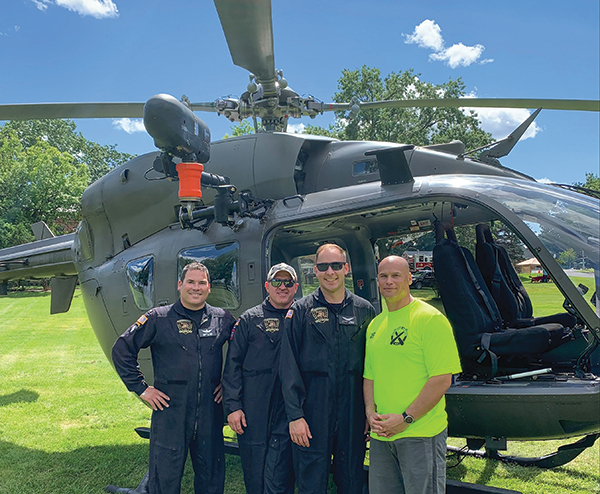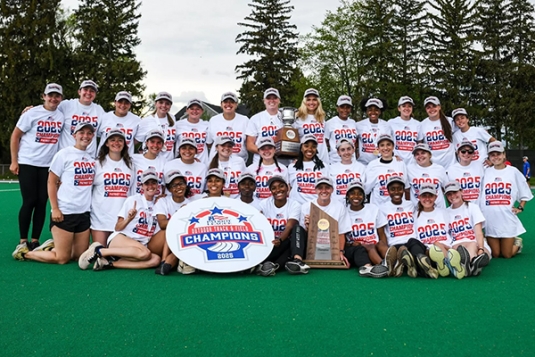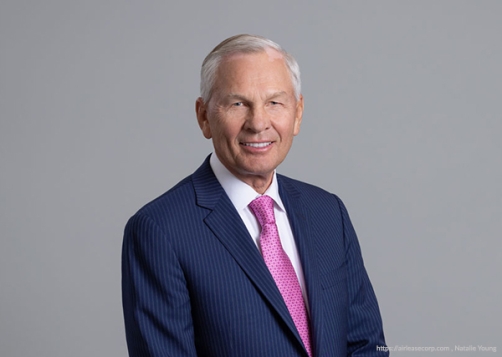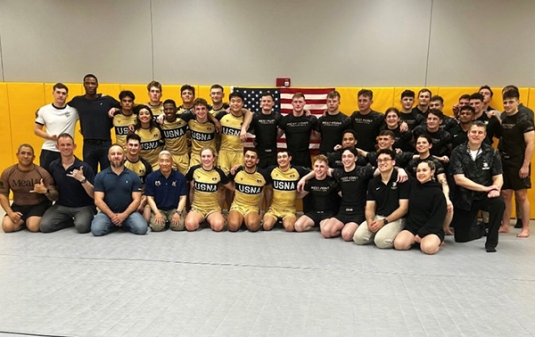By Keith J. Hamel, WPAOG Staff
Their mission is to serve as the “Wings of West Point,” but the warrant officers of the 2nd Aviation Detachment also take pride in introducing cadets to an Army rank seldom seen on Post.
Academy leadership is always seeking ways to foster non-commissioned officer (NCO) interactions with cadets. The officer-NCO relationship is something that vexes many grads when they arrive at their first unit. A few decades ago, Brigadier General David Bramlett ’64, Commandant (1989-92), and Colonel James Siket ’67, Brigade Tactical Officer (1991-94), staffed each cadet company with a TAC NCO in an effort to “bring a degree of the real Army to the Corps’ lifestyle.”
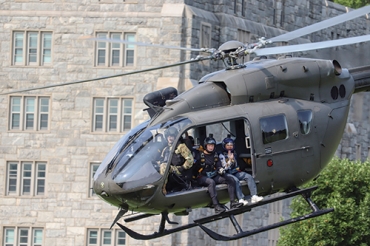
While approximately four dozen NCOs now interact regularly with cadets at West Point, not to mention the dozens more assigned to West Point that work with them during Cadet Summer Training, cadets’ experiences with warrant officers are few and far between. “The best thing about being at West Point is the exposure I provide to cadets regarding the warrant officer rank,” says Chief Warrant Officer 3 Kenneth Rudo, a flight detachment standardization pilot and operations officer with the 2nd Aviation Detachment. “Just to give them insight as to how the Army works outside of a training environment, and the relationships you have with the different people you work with, is really valuable.”
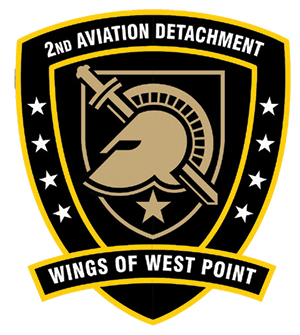
Rudo is one of six warrant officers with the 2nd Aviation Detachment (“Wings of West Point”), a unique unit—its command structure is all warrant officers—housed at Stewart International Airport in Newburgh, New York. The unit’s primary mission is to fly distinguished visitors to West Point and to support the Superintendent’s travel off Post. Its secondary mission is to support the U.S. Corps of Cadets. “Tasked through the USMA Deputy G3, the 2nd Aviation Detachment generally supports the West Point Parachute Team, assists with Academy marketing and outreach, and conducts fly-bys for home football games,” notes Rudo.
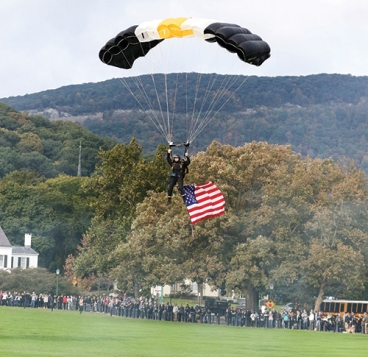
For cadets seeking to learn more about the “real” Army, the warrant officers of the 2nd Aviation Detachment have a lot to offer. “As a unit, we have over 10,000 hours of flying experience,” says Rudo. Furthermore, several of the warrant officers in the 2nd Aviation Detachment have had multiple combat tours. “I’ve done five,” says Rudo: two nine-month tours as an AH-64 Apache pilot in Afghanistan and three tours (two 12-month and one 15-month) in Iraq as an infantryman. While the subject of combat comes up, Rudo mostly wants to discuss leadership and aviation with cadets. “Coming from an instructor pilot background teaching at Fort Rucker, I want to mentor cadets in how to be successful and what they should focus on when they get to their units,” he says. “For those branching Aviation, I advise them on how an Aviation company operates and how to interact with a warrant officer, as most of them don’t get a chance to work with us until brigade level,” Rudo says that he explains to cadets what a warrant officer is, where they come from, and how to best utilize them in order to be a successful leader in their career.
“Before each jump, as my teammates board the helicopter, the pilots set down their flight equipment in order to fist bump each jumper. It’s one of those traditions that highlights the bond our team shares with the 2nd Aviation Detachment and the appreciation we hold for these highly skilled aviators who take time out of their day to teach us valuable skills of in-extremis leadership and camaraderie.”
— CDT Pierce Ederle ’25, West Point Parachute Team member
According to Rudo, the 2nd Aviation Detachment has three major opportunities to influence cadets. The most obvious is the unit’s work with the West Point Parachute Team. “We closely interact with the 40 cadets on the jump team all semester,” says Rudo, “and if the weather cooperates and the team is active, we may see these cadets seven days a week—four to five days being average.” The unit is also present at West Point for Branch Night and Post Night, especially interacting with those cadets branching Aviation or going to Aviation units. Finally, the warrant officers of the 2nd Aviation Detachment love to interact with cadets during home football games.
“Before each jump, as my teammates board the helicopter, the pilots set down their flight equipment in order to fist bump each jumper,” says Cadet Pierce Ederle ’25, a member of the West Point Parachute Team. “It’s one of those traditions that highlights the bond our team shares with the 2nd Aviation Detachment and the appreciation we hold for these highly skilled aviators who take time out of their day to teach us valuable skills of in-extremis leadership and camaraderie.”
“During our night operation training jumps, Chief Warrant Officer Rudo spoke to me and some of my teammates about flight school, what it was like to fly Apaches in Afghanistan, how the 2nd Aviation Detachment operates, and even about his time as an Infantry officer,” says Cadet Faith Riccobene ’26, another member of the West Point Parachute Team. “Interacting with the warrant officers through conversations like this, situations involving flexibility and willingness to serve, has only made me more eager to branch Aviation, and I look forward to learning from them more over my next three years at the Academy.”
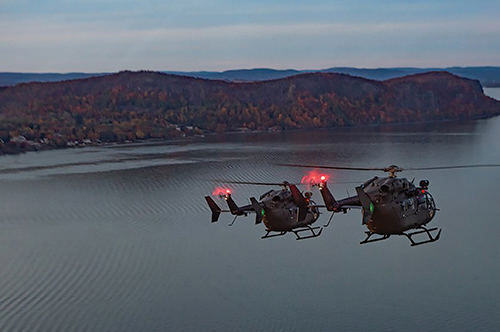
“Chief Warrant Officer Rudo, a prior service infantry platoon sergeant and later Apache pilot instructor, has provided great insight to cadets regarding branch culture, leadership practices, and other advice for future young lieutenants,” says Madeline Rose ’26. “Working with the warrant officers of the 2nd Aviation Detachment, we cadets are able to see firsthand the ‘mission first-people always’ dynamic of the operational Army at play.”
When not working with cadets, the warrant officers of the 2nd Aviation Detachment are busy honing their aviation skills. This typically happens during the summer, when cadets are away from the Academy or busy with summer training. “We’ll practice for the VIP missions that are part of our unique mission set at West Point, or we’ll use our ‘bambi buckets’ to conduct firefighting training or work on our rescue hoist training,” says Rudo. It doesn’t happen often, but the 2nd Aviation Detachment is sometimes called on by the Superintendent to support local municipalities with these latter types of missions. “Just last year, we launched and stood ready to assist with a search for a West Point Middle School student who went off in the woods,” says Rudo. In 2013, the unit performed a nighttime hoist/extraction to rescue an injured hiker located on Breakneck Ridge, a popular hiking mountain located between Beacon, New York, and Cold Spring, New York, on the eastern side of the Hudson River. Less than a week earlier, the 2nd Aviation Detachment responded to a request for support with a massive fire in Rockland County.
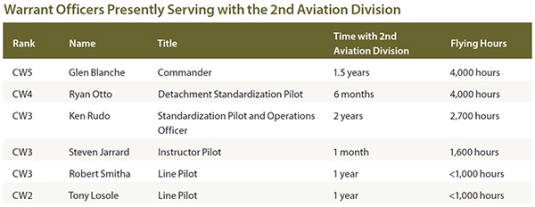
“We also operate with a memorandum of understanding to back up the New York State Police,” says Rudo. The New York State Police shares a hanger with the 2nd Aviation Detachment at the Stewart Army Subpost. “They are like our family,” says Rudo. “We’re always on their side of the hanger talking to them and supporting them,” Rudo notes that this family-oriented environment continues with the other assets housed at Stewart. “We are also close with the Air Force,” he says. “Our three civilian on-staff mechanics conduct maintenance on our aircraft in-house, and if we are missing a part or need to get something quickly, the Air Force folks will help us out, and we’ve helped them out in the past, too.” The comradery even includes Atlantic Aviation, which supplies the 2nd Aviation Detachment with its fuel. “Everyone supports one another here; it’s a really good environment to be in,” says Rudo.
“The warrant officers of the 2nd Aviation Department and I are privileged to work with cadets, hopefully bringing a sense of the real Army to them and positively influencing their development as leaders of character.”
— CW3 Kenneth Rudo
Rudo also enjoys being part of the West Point environment, even though the 2nd Aviation Detachment is stationed more than 15 miles off Post. “I don’t feel any disconnection over distance,” he says. “The fact of the matter is that I can fly to West Point in basically the same amount of time it takes someone entering Post from Stony Lonesome Gate to reach Central Area.” Well, that is if Rudo doesn’t take the “scenic” route, which he is apt to do from time to time. “I love seeing the Academy from the air,” he says. “It stands for America, patriotism and service to our country,” much like the cadets it is charged to train. “Just as cadets do not get many opportunities to interact with a warrant officer, many warrant officers do not get an opportunity to interact with cadets,” says Rudo. “The warrant officers of the 2nd Aviation Department and I are privileged to work with cadets, hopefully bringing a sense of the real Army to them and positively influencing their development as leaders of character.”
Learn about the Department of Civil & Mechanical Engineering’s Academic Flight Program, whose two Cessna planes have a home in the 2nd Aviation Detachment.
Epic 42/43
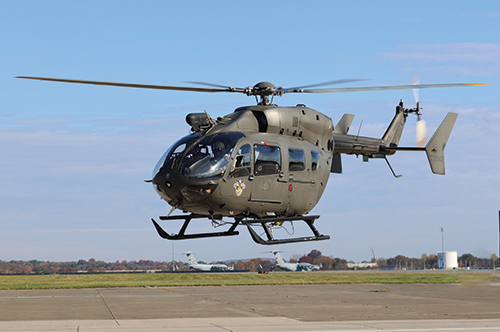
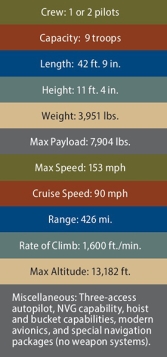
The 2nd Aviation Detachment’s primary aircraft is the UH-72A Lakota, a twin-engine helicopter with a single, four-bladed main rotor and glass cockpit. The unit houses two Lakotas, referred to as “Epic 42” and “Epic 43,” at Stewart International Airport in Newburgh, New York. “They’re the Swiss Army knife of helicopters and perfect for our mission at West Point,” says Chief Warrant Officer 3 Kenneth Rudo, a flight detachment operations officer with the 2nd Aviation Detachment who has more than 2,700 hours piloting the Lakota. A refitted version of the commercial EC145, the UH-72A replaced the UH-1 Iroquois (“Huey”) after 2007 as the U.S. Army’s primary light utility and training helicopter.
“It’s very fast and very agile,” says Rudo. “It takes less than five minutes from launch to reach the Plain, a distance of 14 nautical miles.”
What do you think? Click here to answer 3 questions.

